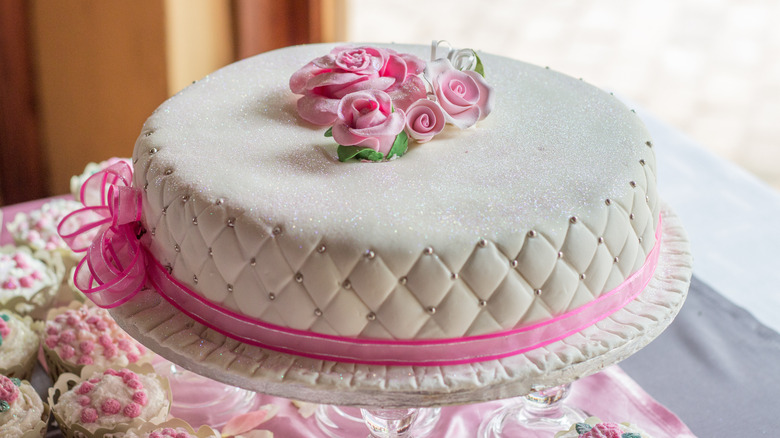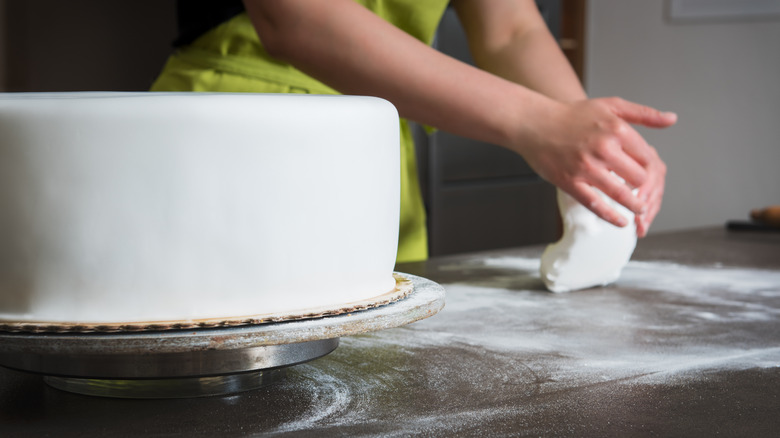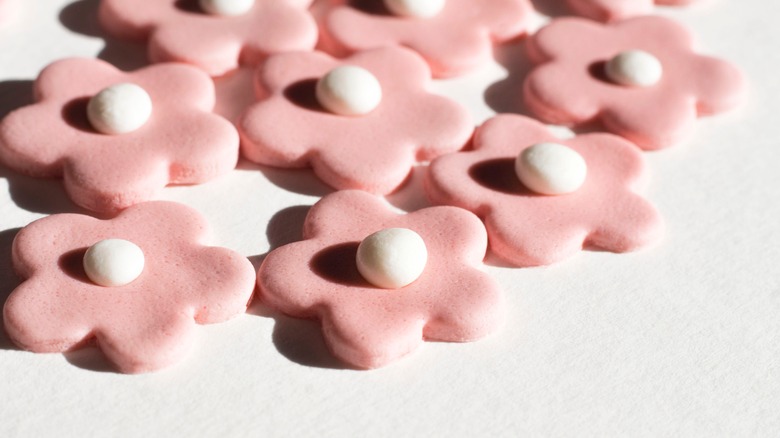The Reason Fondant Frosting Is So Popular For Wedding Cakes
No culinary undertaking comes with more pressure than making a wedding cake, and this fact has only been exacerbated in the 21st century by the rise of social media, where the most glorious cakes imaginable are broadcast for the whole world to envy. If you've ever been down one of these Instagram wormholes yourself, or watched any episodes of "Cake Boss" or "Ace of Cakes," you've probably noticed that the main ingredient separating most wedding cakes from your standard birthday cake is the frosting. Wedding cakes, it seems, are almost always covered in fondant, or at least the really elaborate ones are.
Fondant is the go-to choice for many nuptials, and when you compare it to other types of icing, you can easily see why. Wedding cakes tend to put appearances above all, and fondant is insanely photogenic. It is stiff and pliable, with a smooth, polished finish. Whereas other forms of frosting exist in a near-liquid state, fondant is a firm solid, allowing bakers to sculpt elaborate decorations such as flowers and bows, tasks that would be impossible if using piped-on icing or frosting spread by a knife.
However, you should think carefully before rushing to get yourself a fondant cake, no matter what the occasion is. For all its beauty, fondant is far from perfect, its main drawbacks being flavor, mouthfeel, and price. Let's dig a little deeper into the details to determine when and why you should choose fondant for your cake, or take a different route entirely.
Types of fondant
Broadly speaking, there are two types of fondant — rolled and poured — and each is suited for different purposes. Poured fondant is a thick, creamy fluid that comes in a tub, much like other forms of frosting you might buy in a store. It is often used as a filling for cakes, pastries, and confections. For example, both Oreo cookies and Cadbury Creme Eggs are filled with varieties of poured fondant.
However, while poured fondant can be used to decorate the surface of a cake, rolled fondant is the more popular choice for decorating. Rolled fondant is much firmer than the poured variety, handling more like clay or pastry dough. It gets its name from the fact that it is rolled into large sheets which can be draped over cakes or cut into smaller pieces to mold decorative toppings. Rolled fondant is made from sugar, water, and a stabilizing agent such as corn syrup or tartar. Finally, glycerin or gelatin is added to give it the proper balance of stability and pliability.
If that isn't enough to cover your decorative needs, there are a couple of subcategories of rolled fondant with even greater structural integrity. First, you have sculpting fondant, an especially stiff variety that is commonly used to sculpt detailed figurines, or even busts of the bride and groom. Then, there's gumpaste fondant, which hardens when it dries. Gumpaste is used to craft delicate decorations, like flowers, ensuring they hold their shape indefinitely.
The pros and cons of fondant
The main advantage of using fondant for a wedding cake is its decorative potential. However, there are a few other advantages to fondant that you should also take into consideration. Fondant's sturdy nature makes it easy to store and transport cakes without damaging them, and because rolled fondant creates a tight seal, it acts as an effective preservative, keeping the crumb from going stale or spoiling, and allowing the baker to prepare and perfect the cake in advance. Fondant's simple ingredients also offer an advantage. Before its rise to prominence, marzipan and royal icing were used for similar purposes, but these include almond meal and raw egg whites, respectively, which present concerns for allergies and food safety.
The main downside to fondant is its flavor. It is extremely bland, as it's basically just sugar paste. Compared to the richness of something like buttercream frosting, it offers little to excite the taste buds. For this reason, many weddings actually trick the guests with a cake swap. A baker will prepare a cake made out of styrofoam and coated with fondant decorations, sometimes including a single layer of actual sponge for the cake-cutting ceremony, which is used for photoshoots. Once pictures have been taken, the fake cake is discreetly whisked away, and guests are given slices of a regular sheet cake that was waiting in the back all along. Obviously, this is a more expensive route to take, but for your wedding day, why not go all out?


